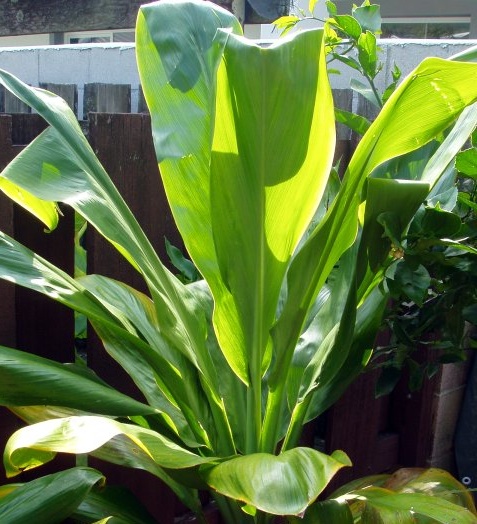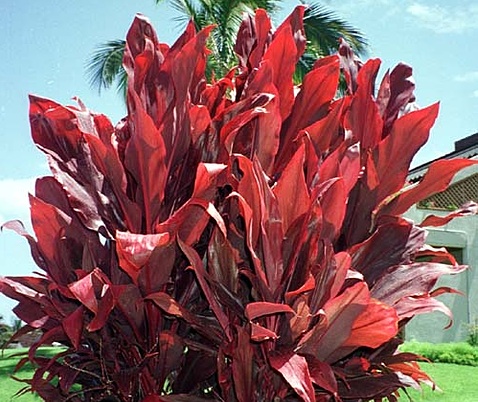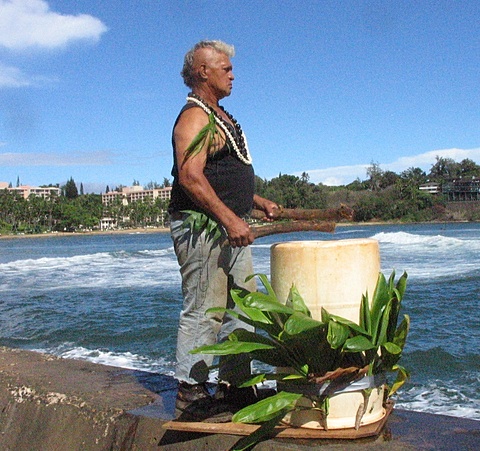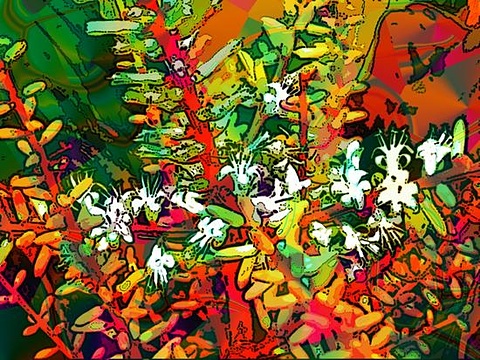Birds and Plants of Kauai:
Ki: Ti Plant
by Linda Pascatore on 26 June 2008

Ki is the Hawaiian name for the Ti plant, also called Si by Tongans, and Auti by the Tahitians. Ki was a canoe plant spread throughout the Polynesian Island chain by settlers traveling in outrigger voyaging canoes. The plant grows in shady, moist areas, and is found in Southeast Asia and the tropical Pacific zone.
Ti, or Ki, is a member of the agave family (in some sources classified in the lily family), and the scientific name is Cordyline terminalis. The plant probably originated in either southeast Asia or Australia. It has a woody base and stalks, and grows from 3 to 12 feet high. The leaves are blade shaped, and grow 1 to 2 feet long, in a spiral cluster at the top of each branch. The leaf has a strong central vein.
There are several varieties of Ti. The most common is green, but red Ti is found often in Hawaii. Many other colors are found through Polynesia and Micronesia, including yellow, green, black and purple. Ti produces small red or yellow flowers that become red berries. However, it is rarely grown from seeds, but instead propagated from stalks cut from plants. These cuttings can be put directly in the soil, or rooted first in water. They should be kept moist until the roots
are established.

The Ti plant has many uses. It’s leaves don’t wilt easily, and can be used to store food or wrap gifts. They are also used to wrap food to be cooked in an imu pit. Hula skirts are made from ti leaves. The leaves are waterproof, and are made into rain capes, or kui lae. They can also be woven into sandals, and to thatch roofs. They can be used as sleds to slide down grassy slopes, or woven into mats for lava sledding. Ti ties are used as lures on fishing nets.
The root can be pounded to make a dye for decorating surf boards.
Ki can also be used as food. Boiled roots can be fermented to make a liquor, okolehao. The root can also be baked in an imu to make a sweet dessert. The leaves were also used as plates to serve food.
There are some medicinal uses of Ki. The leaves are made into a tea for sore muscles. Steam from boiled leaves and stems acts as a decongestant. Flowers are used to treat asthma. Leaves dipped in water can be used as a compress on the forehead to treat headaches, and can also be used as bandages. The leaves can also be wrapped around hot stones and applied for aches and pains.
Ki is a sacred plant to the Native Hawaiians, and is associated with the God Lono. It is also a special plant to the Goddess of the Hula, Laka. Ti leaves are used to make hula skirts. Ti is often displayed at the entrance to homes or property, and is considered good luck and protection against evil. Rows of plants are also used as borders of properties. Ceremonially, Ti symbolizes the law, standing firm in the defense of the right, or Pono, way. Recently Ti leaves were
carried by the protesters of the Superferry, as a statement that they wanted to protect the aina (land).

Ti plants are a common sight today throughout the Hawaiian Islands and Polynesia. They are commonly used in landscaping around homes and resorts. They are also used as greens in many tropical flower arrangements. You will still find gifts to the Gods wrapped in Ti leaf packages at shrines or heiaus, and displayed for protection at the entrances to sacred sites.
|




